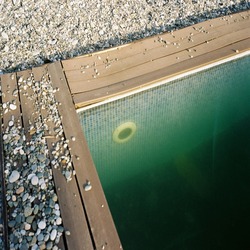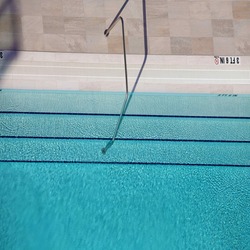How to Change Your Pool Lights
Pool lights not only add an aesthetic quality to your pool, but they also provide some safety measures too. Here at 1st Direct Pools, we stock various lighting systems that you can install in your pool.
Types of Pool Lights
There are two main types of swimming pool lights:
- - Halogen
- - LED
LED Swimming Pool Lights
LED lighting is one of the more popular choices among pool owners because LED lights can be used for both in-ground and above-ground pools.
They are energy efficient and are available in various colours. Thanks to their general brightness, you might only need a couple of bulbs to light up your pool.
Halogen Swimming Pool Lights
Similar to LED lights, halogen pool lights can be used for both above-ground and in-ground pools.
They're useful for lighting the pool over long periods of time, and they're easier to fit/change when compared to LED lights. However, they are only available in one standard colour, unlike LEDs, which can alternate.

How to Change a Pool Light
Before you start installing lights in your pool, you might want to work out how many you'll need. For every 20m² of water surface, one light is recommended. In especially deep pools, one light is recommended for every 25m³.
What You Need to Change a Pool Light
Once you've found out which pool light is compatible with your pool, you'll need to make sure you've got everything ready. To change a swimming pool light, you will need:
- - Replacement bulb
- - Replacement lens gasket
- - Philips and flathead screwdriver
- - Multimeter
- - Dry towels
If you aren't comfortable changing a pool light, there's no reason why you shouldn't call a professional to do the job for you.
Step 1: Turn Off the Mains
Safety is the main priority; it's common knowledge that water and electricity don't mix.
The power needs to be turned off as you will be touching wires while in the water, so before you do anything, make sure to double-check that there is no power on whatsoever.
You can drain some water from the pool as this will make it easier for you to reach and change the bulb. However, you will still need to make sure the mains are off. Once you are finished, the pool will need to be refilled, and the water chemistry will need to be balanced.
Step 2: Remove Pilton Screw
The pilot screw is located on the top of the light. Depending on the light, the screw-type will vary, meaning you will need to use either a flathead or Phillips screwdriver.
Step 3: Remove the Fixture
Before continuing, remember not to touch the wires with your bare hands.
Once the screw has been removed, gently remove the light from the fixture; this may take some prying. You should find enough wire connected to the fixture, allowing you to place it on the deck.
To avoid the lens from becoming scratched, place it on a towel.
Step 4: Test the Wiring
As mentioned above, do not touch the wires with your bare hands. Before anything else is done, the wires should be tested by a multimeter to make sure there is no electricity running through them.
If there is, you'll need to investigate what needs to be turned off before continuing. Once you have determined the source of power, double-check with the multimeter again to confirm it's safe to proceed.
Step 5: Take Apart the Fixture
Remove any screws or clamps that are holding the fixture together. Pull apart the lens, the lens gasket and the face ring so you can reach the pool light bulb.
If the light has eroded over time, you will want to be careful and ensure that you do not dismantle it over the water; this will prevent any pieces of debris from falling in.
Wipe away any dirt or debris with a dry towel. If the fixture is too corroded, you may need to replace it.
Step 6: Remove the Bulb
Grip the bulb with a towel. Gently unscrew the bulb until it's fully detached. Dry the bulb using the towel and clean the fitting.
Step 7: Fit the New Bulb
Once the fitting has been thoroughly cleaned, carefully screw in the new light bulb. Ensure that it's firmly in place but not too tightly screwed in as this can run the risk of breaking the new bulb. Once the bulb is firmly in place, install the lens gasket around the lens and reassemble the fixture.
Step 8: Test the Pool Light
Before the fixture is reinstalled into the pool wall, turn the power on and make sure the light comes on. This should be done quickly as pool lights aren't designed to work out of water for long periods of time.
Once you've confirmed that the light works, make sure to turn the power off again- don't forget to double-check it's off.
Step 9: Check for Leaks
Lower the fixture into the water and check for any escaping air, particularly around the sealed outer edges.
If any air bubbles are present, the fixture will need to be taken apart. Remove it from the water, dry the inside of the fixture and reassemble it out of water.
Lower the fixture into the pool and check again for any air bubbles. Repeat the process until the fixture isn't leaking.
Step 10: Fit the Light
Push any excess wire back into the pool wall, then gently push the fixture into position. Make sure the fixture's screw holes are aligned with the pool wall’s holes so you can screw the fixture in place.
Step 11: Turn on the Mains
Turn the mains back on and double-check the light works; once you're sure the light is in working order, you can sit back and relax after a job well done.
For more advice and information about swimming pools, don't hesitate to get in touch with a member of staff or have a browse through our blog.



